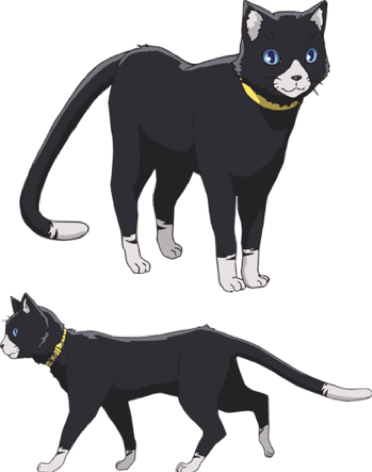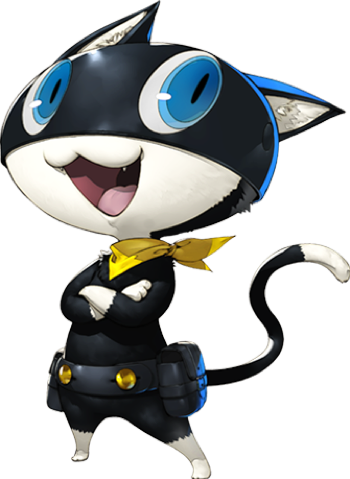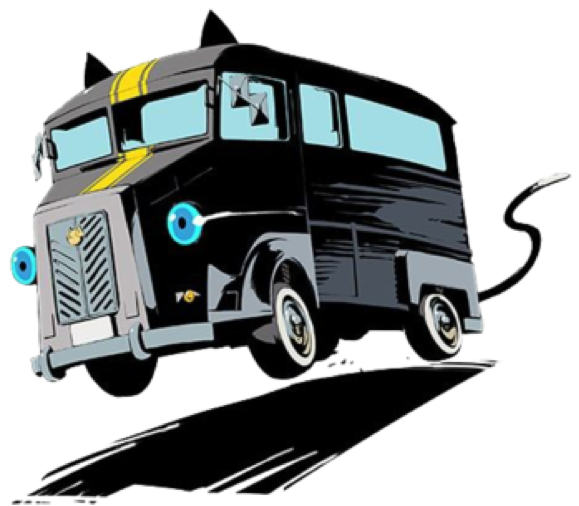At the time this is published, Persona 5 Royal (Persona 5: The Royal in Japan), an updated version of the smash-hit Japanese Role-Playing Game (JRPG) phenomenon Persona 5 (2016), will have just released in Japan on the PlayStation 4. The protagonist of Persona 5 is a high-schooler whose name is left up to the player, but who in Persona 5: The Animation (which tells the same story) is known as Ren Amamiya. One of the most interesting additions to Persona 5 Royal is that Ren’s sidekick/pet cat, the feline mascot character Morgana, seems to have a new human form. Of course, Morgana himself would object to that description, since, despite resembling a cat in every way, he must constantly remind his gang: “neko jyanee yo! ningen da!” (“I am not a cat! I’m a human!”). Morgana is native to, and an ambassador of, the Metaverse, a virtual media space that is simultaneously a metaphysical psychic layer of reality constructed by, and reflective of, human cognition; a manifestation of Jung’s collective unconscious. The Metaverse is Persona 5’s “other world,” to which the characters, characteristic of many anime (e.g. Digimon), must travel in order to save the world. Morgana, like the party of high-schooler human characters in Persona 5 (who come to be known as The Phantom Thieves) is also a cross-dimensional traveler, able to jump between the Metaverse, the 2D virtual media layer and the real world, the “real” 3D layer. Morgana is thus defined by his “2.5 dimensionality” (Nozawa 2013, 14).

Figure 1. Morgana’s “realistic” representation in the real world, where he appears as an anatomically accurate cat.
Unlike The Phantom Thieves, Morgana’s movement between dimensions is also movement between “realistic” (or naturalistic) and “iconic” styles of representation (McCloud 1993, 59). In the real world, Morgana is a quadrupedal realistic cat that Ren carries around in his schoolbag (see Figure 1); in the Metaverse, he is a large-eyed mascot-like bipedal anthropomorphic cat (see Figure 2). Similar to the morphing tanuki of Pom Poko (1994), Morgana embodies the way that “animation itself becomes implicated in the art of shape-shifting” (Heise 2014, 314). With those tanuki in mind, there might be some temptation to denote Morgana as a type of Japanese yōkai (translated at different times as monster, ghost, goblin, and so on). After all, cats bear a privileged position in relation to yōkai through the figure of Nekomata (a cat that, after 100 years, becomes capable of speech). However, in Persona 5, Nekomata is already one of the game’s other types of fantastic creatures: the titular “Persona”. Persona are a series of creatures, not unlike Pokémon, that are captured, trained, and collected. They come from a range of sources: mythology (Odin), folklore (Tengu), fiction (Arsene), and even developer Atlus’ other media properties (Atlus mascot Jack Frost). What unites this heterogeneous group of otherwise seemingly unrelated creatures is their ludonarrative categorization according to their Jungian monomythical self-therapeutic function. This is, in other words, their iconic archetype, which in the Persona series is represented by the major arcana of the Tarot (“Magician”, “Empress”, and so on: the semi-equivalent to Pokémon types). Thus, the population of the Metaverse is defined by their iconic abstract nature, their “stripped-down” qualities that make them, as “characterized” entities, suitable for “decontextualization” and “recontextualization” (Silvio 2019, 45; Nozawa 2013, 13).

One of these recontextualizations transports Morgana to transportation itself. In addition to being a realistic cat and a cartoonish cat (and soon to be a human as well), Morgana can transform into a bus (see Figure 3). Yes, a bus. If that sounds derivative, that is because it is: Morgana, as a being shaped by the collective unconscious directly, notes that his power for transformation is the direct result of some shared psychic connection between “cats” and “buses”, a clear allusion to the influence of My Neighbour Totoro (1988). Morgana then is a remix, a recontextualization of the database elements (or rather, elements of databased entities) such as “Catbus”. After all, the world that created Morgana – the world of Persona – is the world on the other side of the screen (here the cellphone screen, in Persona 4 the television), a world where entities as diverse as “Catbus” and “Thor” can somehow be brought together through their social/psychic impact.

Ultimately, Morgana is more than a vehicle within the Metaverse but also a vehicle to the Metaverse, and to what such a space affords and represents. Morgana invites the human characters (and the human player/viewer by proxy) into the space of 2.5D: to become iconic, archetypal; to take on the transforming mobility of codenames (“Joker”, “Queen”, “Fox”) and to become characterized. What a coincidence then that kyara (character, but distinct from kyarakutaa) “has recently been used to mean ‘persona’, an index that typifies personal demeanor” (Nozawa 2013, 23). And yet Morgana is not a Persona, he has “persona”, and a Persona, named Zorro (remind you of Puss in Boots at all?). In the Persona series then, humans, animals (Koromaru, Persona 3), objects (Aigis/Aegis, a robot in Persona 3), and lastly characters (Morgana and also his predecessor Teddie, Persona 4) are all things that can be “ensouled” by Persona and “persona” (kyara) (Nelson, 30). With the advent of Persona 5 Royal, Morgana transforms into, and shifts between, all of these things. More interestingly, there is some sensibility that this is afforded specifically because he is a cat, leveraging the historic mobility of such a creature, through folklore and popular culture, to states of, and between, humanity, objectness, animality, and the virtual. After all, “the internet is cats.”
References
Hashino, Katsura (2016). Persona 5. [Video game]. Atlus; Tokyo.
Heise, Ursula K. (2014). “Plasmatic Nature: Environmentalism and Animated film”, Public Culture 26.2 (73): 301-318.
Isao, Takahata (1994). Pom Poko. [Film]. Studio Ghibli; Tokyo.
McCloud, Scott (1993). Understanding Comics. The Invisible Art, New York: William Morrow.
Miyazaki, Hayao (1988). My Neighbour Totoro. [Film]. Studio Ghibli; Tokyo.
Nelson, Victoria (2009). The Secret Life of Puppets, Cambridge: Harvard University Press.
Nozawa, Shunsuke (2013). “Characterization”, Semiotic Review 3.
Silvio, Teri (2019). Puppets, Gods, and Brands: Theorizing the Age of Animation from Taiwan, Honolulu: University of Hawaii Press.
Cole Armitage completed his BA in Media Studies at Trent University in Peterborough, Ontario, Canada. He is currently a student in the Film Studies MA program at Concordia University in Montrèal, Québec, Canada. His research interests are animation, autonomy and control, nonhumans, comics and webtoons, and video games. He is currently writing his MA thesis, Deanimation: The Experience of Nonhuman Agency in AnimatedMedia, on the subversion of a “viewer-as-animator” model in media experiences across different media forms, including webtoons and video games.

3D, Vfx animation services